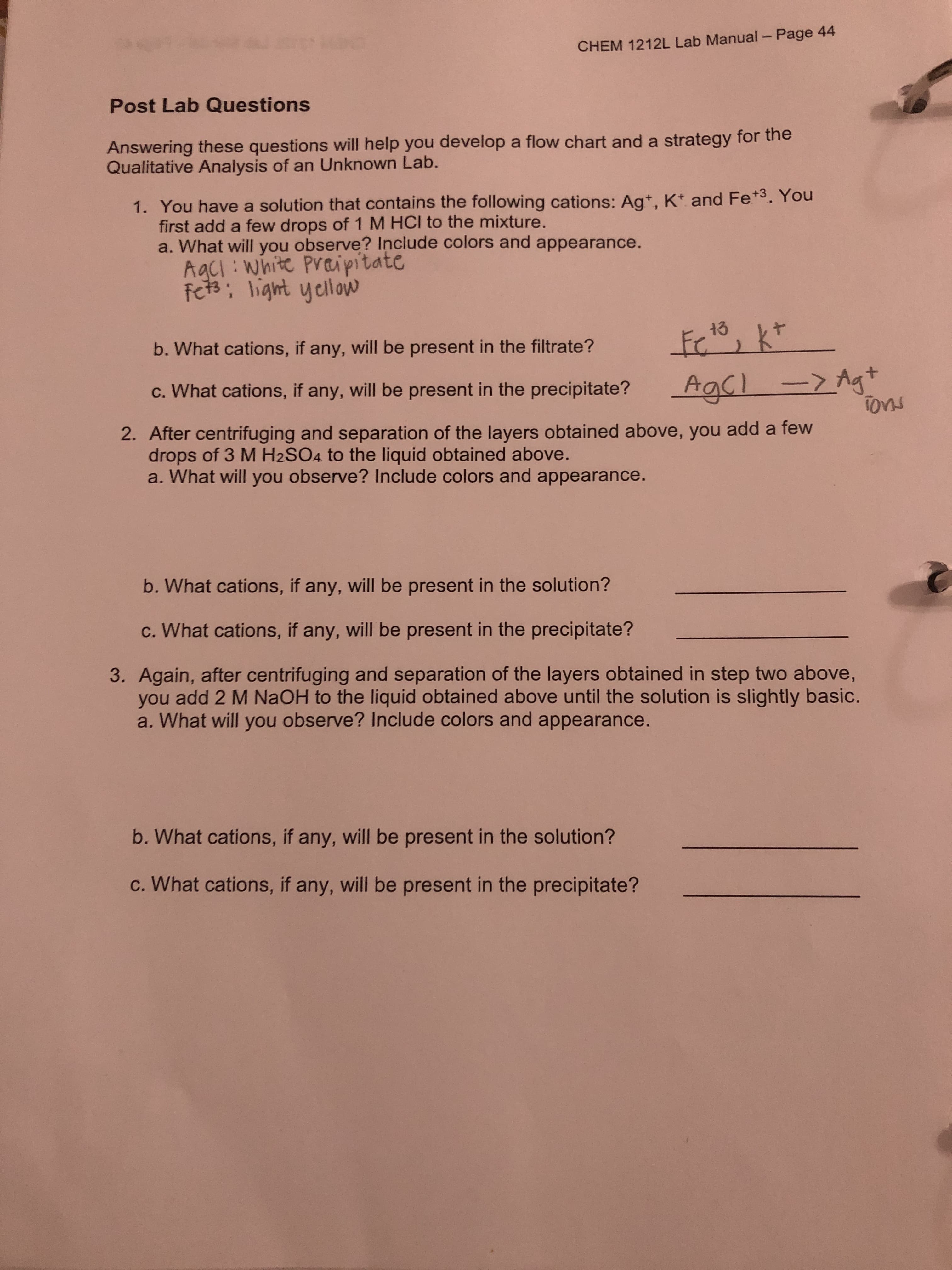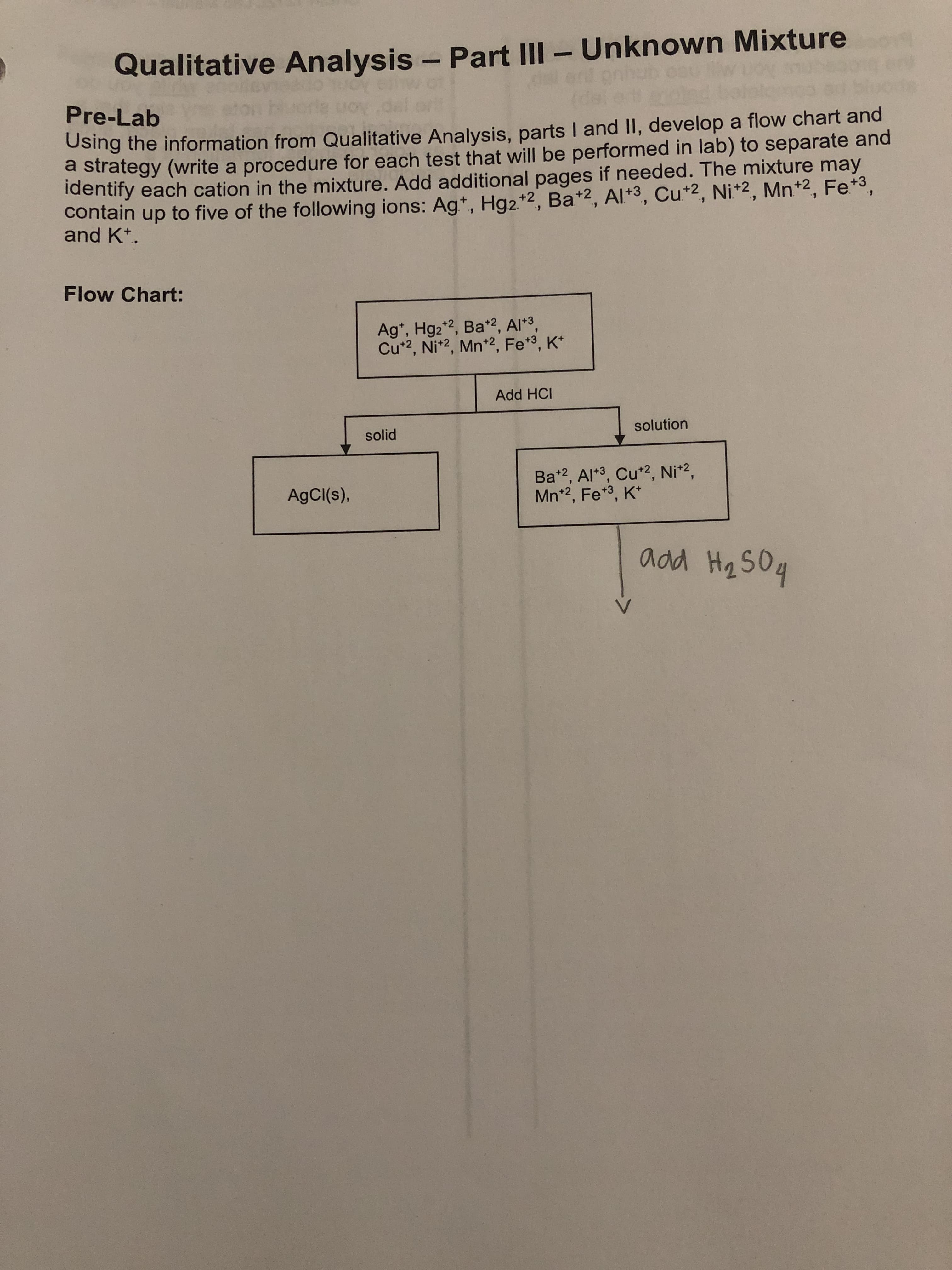CHEM 1212L Lab Manual- Page 44 Post Lab Questions Answering these questions will help you develop a flow chart and a strategy for the Qualitative Analysis of an Unknown Lab. 1. You have a solution that contains the following cations: Ag*, K* and Fe*3. You first add a few drops of 1 M HCI to the mixture. a. What will you observe? Include colors and appearance. AgCI : white Praipitate fets; light yellow 13 b. What cations, if any, will be present in the filtrate? ->Ag+ Tons AgCl c. What cations, if any, will be present in the precipitate? 2. After centrifuging and separation of the layers obtained above, you add a few drops of 3 M H2SO4 to the liquid obtained above. a. What will you observe? Include colors and appearance. b. What cations, if any, will be present in the solution? c. What cations, if any, will be present in the precipitate? 3. Again, after centrifuging and separation of the layers obtained in step two above, you add 2 M NaOH to the liquid obtained above until the solution is slightly basic. a. What will you observe? Include colors and appearance. b. What cations, if any, will be present in the solution? c. What cations, if any, will be present in the precipitate? Qualitative Analysis – Part II- Unknown Mixture Pre-Lab Using the information from Qualitative Analysis, parts I and II, develop a flow chart and a strategy (write a procedure for each test that will be performed in lab) to separate and Identify each cation in the mixture. Add additional pages if needed. The mixture may contain up to five of the following ions: Ag*, Hg2+2, Ba*2, AI*3, Cu*2, Ni*2, Mn*2, Fe*3, and K*. Flow Chart: Ag*, Hg2*2, Ba*2, Al*3, Cu2, Ni*2, Mn*2, Fe*3, K* Add HCI solution solid Ba2, Al*8, Cu*2, Ni2, Mn*2, Fe*3, K* AgCI(s), add Hq SOq
CHEM 1212L Lab Manual- Page 44 Post Lab Questions Answering these questions will help you develop a flow chart and a strategy for the Qualitative Analysis of an Unknown Lab. 1. You have a solution that contains the following cations: Ag*, K* and Fe*3. You first add a few drops of 1 M HCI to the mixture. a. What will you observe? Include colors and appearance. AgCI : white Praipitate fets; light yellow 13 b. What cations, if any, will be present in the filtrate? ->Ag+ Tons AgCl c. What cations, if any, will be present in the precipitate? 2. After centrifuging and separation of the layers obtained above, you add a few drops of 3 M H2SO4 to the liquid obtained above. a. What will you observe? Include colors and appearance. b. What cations, if any, will be present in the solution? c. What cations, if any, will be present in the precipitate? 3. Again, after centrifuging and separation of the layers obtained in step two above, you add 2 M NaOH to the liquid obtained above until the solution is slightly basic. a. What will you observe? Include colors and appearance. b. What cations, if any, will be present in the solution? c. What cations, if any, will be present in the precipitate? Qualitative Analysis – Part II- Unknown Mixture Pre-Lab Using the information from Qualitative Analysis, parts I and II, develop a flow chart and a strategy (write a procedure for each test that will be performed in lab) to separate and Identify each cation in the mixture. Add additional pages if needed. The mixture may contain up to five of the following ions: Ag*, Hg2+2, Ba*2, AI*3, Cu*2, Ni*2, Mn*2, Fe*3, and K*. Flow Chart: Ag*, Hg2*2, Ba*2, Al*3, Cu2, Ni*2, Mn*2, Fe*3, K* Add HCI solution solid Ba2, Al*8, Cu*2, Ni2, Mn*2, Fe*3, K* AgCI(s), add Hq SOq
Chemistry
10th Edition
ISBN:9781305957404
Author:Steven S. Zumdahl, Susan A. Zumdahl, Donald J. DeCoste
Publisher:Steven S. Zumdahl, Susan A. Zumdahl, Donald J. DeCoste
Chapter1: Chemical Foundations
Section: Chapter Questions
Problem 1RQ: Define and explain the differences between the following terms. a. law and theory b. theory and...
Related questions
Question
Help me on these problems please!

Transcribed Image Text:CHEM 1212L Lab Manual- Page 44
Post Lab Questions
Answering these questions will help you develop a flow chart and a strategy for the
Qualitative Analysis of an Unknown Lab.
1. You have a solution that contains the following cations: Ag*, K* and Fe*3. You
first add a few drops of 1 M HCI to the mixture.
a. What will you observe? Include colors and appearance.
AgCI : white Praipitate
fets; light yellow
13
b. What cations, if any, will be present in the filtrate?
->Ag+
Tons
AgCl
c. What cations, if any, will be present in the precipitate?
2. After centrifuging and separation of the layers obtained above, you add a few
drops of 3 M H2SO4 to the liquid obtained above.
a. What will you observe? Include colors and appearance.
b. What cations, if any, will be present in the solution?
c. What cations, if any, will be present in the precipitate?
3. Again, after centrifuging and separation of the layers obtained in step two above,
you add 2 M NaOH to the liquid obtained above until the solution is slightly basic.
a. What will you observe? Include colors and appearance.
b. What cations, if any, will be present in the solution?
c. What cations, if any, will be present in the precipitate?

Transcribed Image Text:Qualitative Analysis – Part II- Unknown Mixture
Pre-Lab
Using the information from Qualitative Analysis, parts I and II, develop a flow chart and
a strategy (write a procedure for each test that will be performed in lab) to separate and
Identify each cation in the mixture. Add additional pages if needed. The mixture may
contain up to five of the following ions: Ag*, Hg2+2, Ba*2, AI*3, Cu*2, Ni*2, Mn*2, Fe*3,
and K*.
Flow Chart:
Ag*, Hg2*2, Ba*2, Al*3,
Cu2, Ni*2, Mn*2, Fe*3, K*
Add HCI
solution
solid
Ba2, Al*8, Cu*2, Ni2,
Mn*2, Fe*3, K*
AgCI(s),
add Hq SOq
Expert Solution
This question has been solved!
Explore an expertly crafted, step-by-step solution for a thorough understanding of key concepts.
This is a popular solution!
Trending now
This is a popular solution!
Step by step
Solved in 3 steps

Knowledge Booster
Learn more about
Need a deep-dive on the concept behind this application? Look no further. Learn more about this topic, chemistry and related others by exploring similar questions and additional content below.Recommended textbooks for you

Chemistry
Chemistry
ISBN:
9781305957404
Author:
Steven S. Zumdahl, Susan A. Zumdahl, Donald J. DeCoste
Publisher:
Cengage Learning

Chemistry
Chemistry
ISBN:
9781259911156
Author:
Raymond Chang Dr., Jason Overby Professor
Publisher:
McGraw-Hill Education

Principles of Instrumental Analysis
Chemistry
ISBN:
9781305577213
Author:
Douglas A. Skoog, F. James Holler, Stanley R. Crouch
Publisher:
Cengage Learning

Chemistry
Chemistry
ISBN:
9781305957404
Author:
Steven S. Zumdahl, Susan A. Zumdahl, Donald J. DeCoste
Publisher:
Cengage Learning

Chemistry
Chemistry
ISBN:
9781259911156
Author:
Raymond Chang Dr., Jason Overby Professor
Publisher:
McGraw-Hill Education

Principles of Instrumental Analysis
Chemistry
ISBN:
9781305577213
Author:
Douglas A. Skoog, F. James Holler, Stanley R. Crouch
Publisher:
Cengage Learning

Organic Chemistry
Chemistry
ISBN:
9780078021558
Author:
Janice Gorzynski Smith Dr.
Publisher:
McGraw-Hill Education

Chemistry: Principles and Reactions
Chemistry
ISBN:
9781305079373
Author:
William L. Masterton, Cecile N. Hurley
Publisher:
Cengage Learning

Elementary Principles of Chemical Processes, Bind…
Chemistry
ISBN:
9781118431221
Author:
Richard M. Felder, Ronald W. Rousseau, Lisa G. Bullard
Publisher:
WILEY